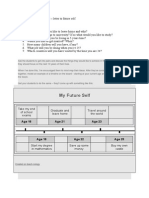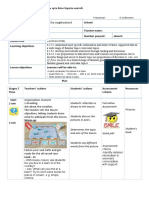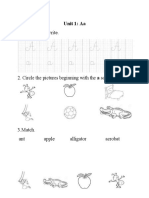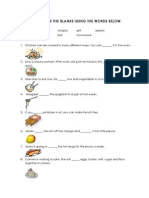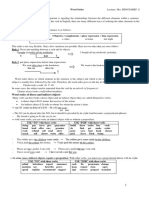Lesson Plan For Unit 1 (Part 1) : Theme: The Animal World
Uploaded by
Hannah DYLesson Plan For Unit 1 (Part 1) : Theme: The Animal World
Uploaded by
Hannah DY1 Lesson Plan For Unit 1 (Part 1) 45 min
Theme: The Animal World
Focus: Grammar Vocabulary Comprehension Writing
• Direct and indirect objects • Suffixes ‘ous’‚ ‘ful’ and ‘less’ Answering Writing a story based on
• Subject-verb agreement • Animal names used as questions based pictures using guiding
(collective nouns) verbs on a visual text question and helping words
Lesson Objectives Resources
Students are able to (Preparation to be done before the lesson)
1. use collective nouns for groups of 1. Learning English Workbook 4
animals, 2. A poster of groups of animals on a farm
2. apply the correct subject verb agreement 3. Picture cards of animals in groups (refer to
for collective nouns, the collective nouns in the box on page 2)
3. describe animals using suffixes such as 4. Word cards with the ‘-ous’, ‘-ful’, and
‘-ous’, ‘-ful’, and ‘-less’, ‘-less’ on each of them
4. answer questions based on a visual text. 5. A piece of paper containing sentences
about animals (Ensure that the sentences
contain the answers to the words in
brackets shown on pages 3 – 4[B]I.)
6. Visualizer projector
7. A box that has been wrapped with layers
of wrapping paper (Make sure that on
some layers, there are sentences that
require the students to complete using
collective nouns, subject verb agreement
or changing root words using suffixes
‘-ous’, ‘-ful’, and ‘-less’.)
8. CD player with music CD
Introduction / Warm-up Activity (10 min)
1. Show the students a poster of a farm. Ask the students to name the animals. Write the names
of the animals on the whiteboard.
2. Next, ask the students if they notice anything about how the animals are placed on the farm. Let
them tell you that they notice the animals are placed in groups. Write down the word ‘group’ on
the whiteboard. Make sentences with the word ‘group’ with the animals seen in the poster.
Example:
• There is a group of horses in the stable.
• A group of sheep is in the meadow.
Learning English 4
© Singapore Asia Publishers Pte Ltd. All rights reserved.
Reproducible for home/classroom use only. 1
STRICTLY NOT FOR SALE. Lesson Plan 1
Look for other useful resources: www.sapgrp.com
Lesson Plans for Learning Englis1 1 1/25/2017 12:15:36 PM
Lesson (20 min)
1. Tell the students that when a group of people, animals or things are taken together and spoken
as a whole, we can use the collective noun. Point to the groups of horse and sheep in the poster
separately. Then, refer the students to the sentences written earlier on the whiteboard. Show the
students how the collective nouns are used.
Example:
• a group of horses a team of horses
• a group of sheep a flock of sheep
Underline the collective nouns. Refer the students to the other groups of people, animals or
things on the poster. Get them to guess what their collective nouns are. If they are unable to,
provide them with the collective nouns.
2. Show the students a picture card of a group of eggs in a nest. Stick it on the whiteboard.
Construct a sentence about the picture. Write the sentence on the whiteboard.
Example:
• A clutch of eggs is in the nest.
Tell the students that when they talk about one group of people, animals or things, they use the
collective noun in the singular form and its verb is also singular. Underline the words ‘clutch’
(singular collective noun) and ‘is’ (singular verb) in the sentence.
3. Next, show the students another picture card of a group of eggs in a nest. Stick it next to the
first picture. Construct a sentence about the two similar pictures. Write the sentence on the
whiteboard.
Example:
• There are clutches of eggs in the nests. / Two clutches of eggs are in the nests.
Point out to the students that if there is more than one group of people, animals or things, the
collective noun used has to be in the plural form. Hence, the verb must also be plural. Underline
the words ‘clutches’ (plural collective noun) and ‘are’ (plural verb) in the sentence.
4. Show the students some other picture cards. Get the students to construct sentences using the
collective nouns and with singular or plural verbs. Write their sentences on a piece of paper
on the visualizer projector so that the whole class can see how the sentences are constructed.
Recapitulate with the students the subject verb agreement rule for each sentence constructed.
5. Use the visualizer projector to show a piece of paper with sentences on it. Read the sentences, one
at a time, with the students. Point out to the students the words with suffixes in the sentences.
Tell the students that a suffix is an addition of a set of letters at the back of a root word to form
another word.
Example:
• use useful / useless
Tell the students that applying the suffix at the end of a root word can change or add to its
meaning. Focus on the suffixes ‘-ous’, ‘-ful’, and ‘-less’ in the sentences shown to the students.
6. Stick the word cards with ‘-ous’, ‘-ful’, and ‘-less’ on them. Provide the students with words that
require them to add suffixes. Write the words on the whiteboard. Then, get the students to
change the root words by adding the correct suffixes. Write their responses on the whiteboard
next to each root word. You may want the students to construct sentences after they have added
suffixes to the root words.
Learning English 4
© Singapore Asia Publishers Pte Ltd. All rights reserved.
Reproducible for home/classroom use only. 2
STRICTLY NOT FOR SALE. Lesson Plan 1
Look for other useful resources: www.sapgrp.com
Lesson Plans for Learning Englis2 2 1/25/2017 12:15:37 PM
Additional Activities / Closure (15 min)
1. Get the students to form a circle. Give a student a box that is wrapped with wrapping paper.
Tell the student that you will be playing some music. As the music is being played, the students
have to pass the box to the student on their right. The parcel has to be passed on until the music
stops. The student holding on to the box when the music has stopped has to rip the first layer
of wrapping paper and check if there is any instruction/sentence. If there is, the student has to
answer the question. If there isn’t, the student needs to wait for the music to start again to pass
the box around.
2. Tell the students to turn to pages 2 – 4 of Learning English Workbook 4. Review the ‘Read
and Learn’ section on page 1. Get the students to complete their work and hand it in to you.
You may want to walk around the class to do a random check on the students’ work.
Homework
1. Ask the students to complete pages 5 – 6 as homework. Go through the visual text together with
the students. Explain to them any words or phrases that may be unfamiliar to them. Ask them
questions about the visual text. Get them to tell you where or how they derived the answers.
2. Students should either write their homework details in their student handbooks or fold the
pages of their workbooks.
Optional Activity
1. Encourage the students to write a short story using collective nouns. However, tell the students
to deliberately use the wrong collective noun for the groups of people, animals or things. Get
them to share their stories with their classmates during the next lesson. Let their classmates
identify the wrong collective nouns and replace them accordingly.
Example:
• Suddenly, I saw a brood of ants marching up towards me. They surrounded me and then,
carried me towards a mob of snakes. I screamed so loudly that I woke up from my dream.
Learning English 4
© Singapore Asia Publishers Pte Ltd. All rights reserved.
Reproducible for home/classroom use only. 3
STRICTLY NOT FOR SALE. Lesson Plan 1
Look for other useful resources: www.sapgrp.com
Lesson Plans for Learning Englis3 3 1/25/2017 12:15:37 PM
You might also like
- English Lesson Plan For Grade 11-Unit 7A-English Grade 11 CambodiaNo ratings yetEnglish Lesson Plan For Grade 11-Unit 7A-English Grade 11 Cambodia6 pages
- ScienceLesson Plans - Macmillan GatewayScience - Grade10 - MacmillanEducationKazakhstanNo ratings yetScienceLesson Plans - Macmillan GatewayScience - Grade10 - MacmillanEducationKazakhstan301 pages
- Flipped Video Classroom: Grammar Movie Video LinkNo ratings yetFlipped Video Classroom: Grammar Movie Video Link1 page
- English Lesson Plans For Grade 6: Lessons in This SectionNo ratings yetEnglish Lesson Plans For Grade 6: Lessons in This Section16 pages
- Vocabulary - Reading & Writing - Clothes - Beginner AdultsNo ratings yetVocabulary - Reading & Writing - Clothes - Beginner Adults3 pages
- Islcollective Worksheets Advanced c1 Adult High School Speaking Activity Conver Cae Type Interview 2769851176e85c72d68 62927770No ratings yetIslcollective Worksheets Advanced c1 Adult High School Speaking Activity Conver Cae Type Interview 2769851176e85c72d68 629277706 pages
- Dairy Products Exercise For Practicing Technical Vocabulary LoNo ratings yetDairy Products Exercise For Practicing Technical Vocabulary Lo2 pages
- Grammar in Use - Unit 2, 3 - Present Simle and Present ContinuousNo ratings yetGrammar in Use - Unit 2, 3 - Present Simle and Present Continuous4 pages
- Detailed Lessonplan in FRENCH CUISINE GROUP-4100% (1)Detailed Lessonplan in FRENCH CUISINE GROUP-424 pages
- 00 - Exploring Reading Very Easy 1 - WorkbookNo ratings yet00 - Exploring Reading Very Easy 1 - Workbook40 pages
- Macmillan English 6 Unit 4 Worksheet Teaching Notes: Find Three or Four Letter Words Inside The Country Names100% (1)Macmillan English 6 Unit 4 Worksheet Teaching Notes: Find Three or Four Letter Words Inside The Country Names2 pages
- (Group 2) Chocolate Lesson Plan OutlineNo ratings yet(Group 2) Chocolate Lesson Plan Outline55 pages
- A. Word Practice: Unit 1 Apple Exploring Reading - Very Easy 1No ratings yetA. Word Practice: Unit 1 Apple Exploring Reading - Very Easy 141 pages
- Describing People - Body and Physical AppearanceNo ratings yetDescribing People - Body and Physical Appearance23 pages
- English For Mechanical Engineering Student's Book 3: 1. Overall ObjectivesNo ratings yetEnglish For Mechanical Engineering Student's Book 3: 1. Overall Objectives18 pages
- Write The Correct Form of The Verb in Brackets (Present Simple)No ratings yetWrite The Correct Form of The Verb in Brackets (Present Simple)2 pages
- Reading Comprehension Worksheet Eiffel Tower100% (1)Reading Comprehension Worksheet Eiffel Tower2 pages
- EXPLICIT-TEACHING-LP.docx-ENGLISH.3docxNo ratings yetEXPLICIT-TEACHING-LP.docx-ENGLISH.3docx17 pages
- "'A MODEST PROPOSAL' Is An Ironical Essay."-Would It Be Possible To Read This Essay As A Serious One?No ratings yet"'A MODEST PROPOSAL' Is An Ironical Essay."-Would It Be Possible To Read This Essay As A Serious One?3 pages
- The Effect of Blended Learning To The Students' Achievement in Grammar ClassNo ratings yetThe Effect of Blended Learning To The Students' Achievement in Grammar Class16 pages
- Parental Involvement Impact On A Child SNo ratings yetParental Involvement Impact On A Child S4 pages
- Collective Noun Farm: Learning ObjectivesNo ratings yetCollective Noun Farm: Learning Objectives6 pages
- LH Pre-Intermediate Teacher's Book WorksheetsNo ratings yetLH Pre-Intermediate Teacher's Book Worksheets70 pages
- Extended Readings: Chapter 2 Discourse and SocietyNo ratings yetExtended Readings: Chapter 2 Discourse and Society4 pages
- PART 2 I Grammar and Capitalization: It Riler's TipNo ratings yetPART 2 I Grammar and Capitalization: It Riler's Tip13 pages
- p.4 Primary Four MTC Scheme of Work Teacher - Ac100% (5)p.4 Primary Four MTC Scheme of Work Teacher - Ac24 pages
- Mber Facts: 2-Digit Number 3-Digit 4-Digit N MberNo ratings yetMber Facts: 2-Digit Number 3-Digit 4-Digit N Mber13 pages
- Cambridge IGCSE™: French 0520/43 May/June 2021No ratings yetCambridge IGCSE™: French 0520/43 May/June 202112 pages








